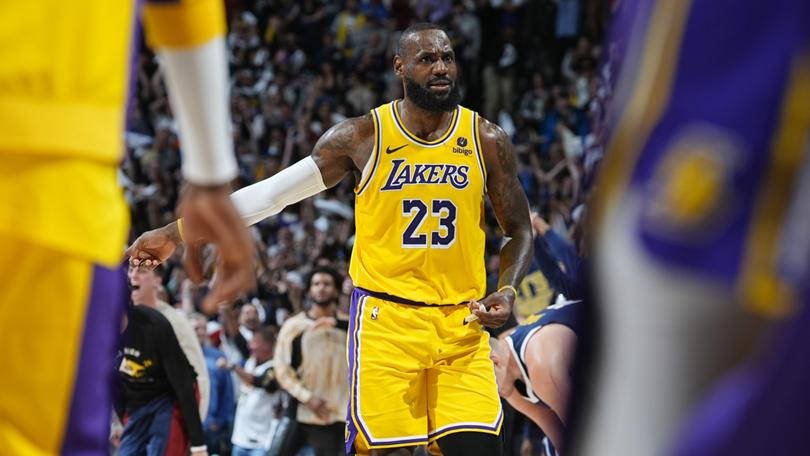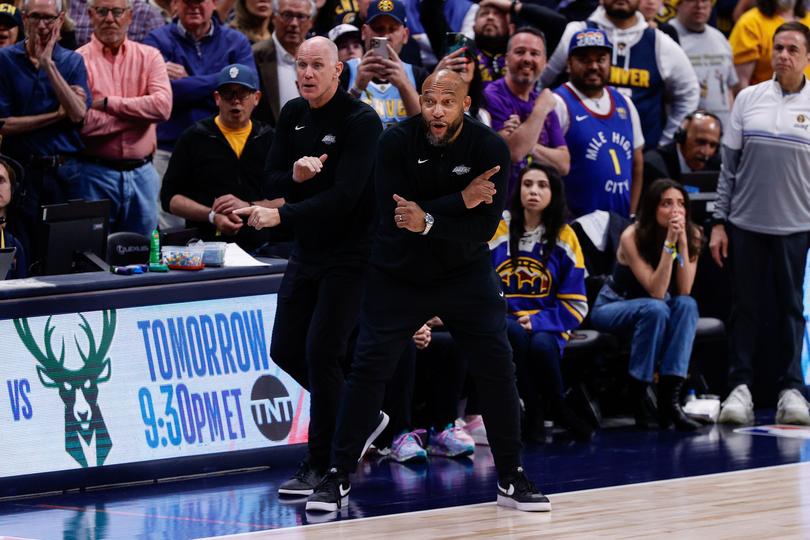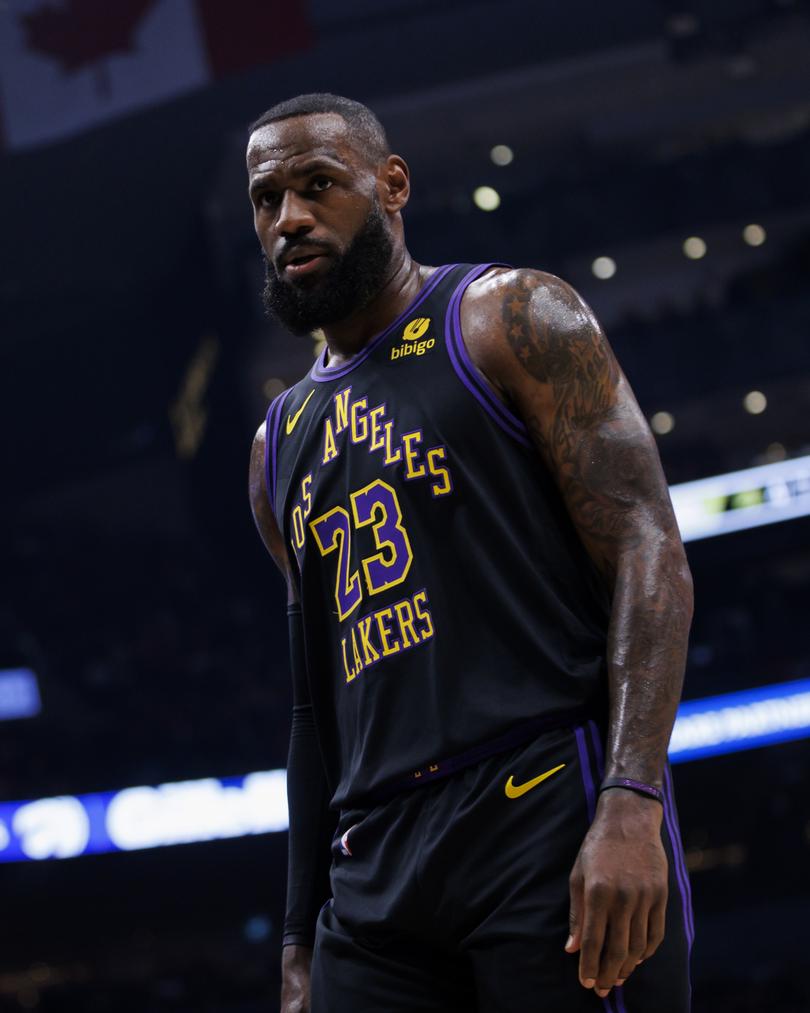What’s next for the Los Angeles Lakers, LeBron James and Darvin Ham after NBA season gone wrong?

The season began with high hopes for the Los Angeles Lakers, after their Western Conference finals appearance against Denver last year.
The Lakers saw their roster as built for success. General manager Rob Pelinka and his staff retained key free agents and believed the core had promise to make a title run around LeBron James and Anthony Davis.
But by the time the Lakers’ season ended in Game 5 against Denver on Monday night, when Jamal Murray’s second game-winner of the first-round series sent the Lakers home less than a year after the Nuggets swept them last May, there were strong signs within the organization that the responsibility would be placed with the second-year coach, Darvin Ham.
Sign up to The Nightly's newsletters.
Get the first look at the digital newspaper, curated daily stories and breaking headlines delivered to your inbox.
By continuing you agree to our Terms and Privacy Policy.The Lakers’ unflattering finish leaves Ham’s future as their head coach in serious peril, people within the team and around the league told The Athletic. The plan is to reassess everything that went wrong in the coming days before making a final decision on the coach. In 2022, Ham signed a four-year deal in the range of $5 million per season, so the team would be assuming the remainder of his deal if he is fired.
“It seemed like every time we hit a rhythm, somebody, a key piece, would fall out of the lineup. It is what it is, man,” Ham said after the Game 5 defeat. “I’m not going to feel sorry for myself, for ourselves. It’s an unbelievable franchise to represent.”
He added: “But I’ve seen a lot my first two years in this seat. I’ll continue to work, to get better and to control what I can control.”
Throughout the series and most of the season, team officials and players believe that Ham’s fluctuating rotations, game plans and lack of adjustments led to an underperforming group. It created discontent within the locker room, which became palpable across the franchise.
The Lakers’ blown 20-point lead in Game 2 of the Denver series served as a final straw of sorts. After a successful first year as coach in which Ham showed signs as a leader of players, the tide turned for him this season. There was tremendous respect for Ham as a person, and players had an appreciation for his pro career and time as an assistant coach in Atlanta and Milwaukee. But, as one player said recently, “We need to be coached, too.”
Now, the Lakers face two franchise-defining questions.
Will James Stay in Laker Land?
James just wrapped up his 21st NBA season, and he has a $51.4 million player option for the 2024-25 season.
Before his June 29 option date, James will likely want to see how the Lakers manage the offseason and their approach to building the roster around him and Davis. Both routes — opting in and opting out — are on the table. He places importance on having comprehensive and well-rounded depth around him, which could mean that the Lakers will explore trades in the lead-up to that player option.
What’s more, people within the Lakers organization are open to the prospect of helping James fulfill his dream of playing with his son Bronny by potentially drafting him.
“My last year will be played with my son,” James told The Athletic in 2022.
James changed his message in January 2023, telling ESPN that he would consider that family goal fulfilled so long as he shared the floor with Bronny “either in the same uniform or a matchup against him.” In the wake of Bronny’s cardiac arrest episode in July, he had an uneven freshman season at Southern California, and his NBA future is hard to handicap.

As for his father, the Lakers want him back — badly — and the potential of the 39-year-old James returning remains the most likely scenario. Lakers owner Jeanie Buss, in particular, believes James’ return is of paramount importance to their plan. This franchise has always been buoyed by its stars, and James’ ability to play at an elite level at his advanced age has only strengthened the desire to have him retire in a purple-and-gold jersey one day.
And after six seasons together in which there has been no shortage of ups and downs, Buss and James, people within the team say, have a relationship that is better than ever these days.
But James has made a habit of keeping his options open for most of his storied career, and this time around will likely be no different.
“I just want to get home to the family, honestly,” James said after Game 5 when asked about his future. “Started looking at the schedule, obviously I’ve got one of my boys trying to decide if he’s going to enter the draft or go back to school. I’ve got another kid that’s playing AAU ball right now. My daughter is playing volleyball. And my wife is doing so many great things. So it’s about family right now. Then, in a couple months, I got to go to Vegas for training camp. So I need to rest my body” before the Olympics.
When asked later if he thought Game 5 might have been his last game as a Laker, he said: “I’m not going to answer that. I appreciate it.”
Where Did Ham Go Wrong?
In the eyes of the Lakers’ top decision-makers, the combination of last season’s West finals appearance and December’s in-season tournament championship were signs that this roster was worthy of contention. The pressure was on Ham to make the most of it. But just as the momentum started to build, with the stability the organization had longed for in Ham’s tenure within reach, the Lakers’ skid began.
They lost 10 out of 13 games after the in-season tournament, with two four-game losing streaks during that stretch. The Lakers were largely healthy during that stretch — only D’Angelo Russell (four games) and Gabe Vincent (12 games) missed notable time from their normal rotation. Outside of that period, the team went 44-25, a 52-win pace. If the Lakers had won a few more games during that losing stretch, they would have finished at least sixth in the West, which would have kept them out of the play-in tournament and away from facing Denver in the first round.

During the 13-game skid, the Lakers used six starting lineups, including two variations of an all-wing lineup — James, Davis, Taurean Prince, Jarred Vanderbilt and either Cam Reddish or Rai Hachimura — for five games (the team went 2-3). The decision to bench both Austin Reaves and Russell, the team’s consensus third- and fourth-best players, did not sit well with many, according to people within the organization.
The buzzword of the Lakers’ offseason and training camp had been continuity. They believed their supporting cast around James and Davis — specifically Reaves, Russell, Hachimura and Vanderbilt — complemented the stars and one another well. All four players were in their mid-to-late 20s and under contract for at least one additional season. The plan was for the Lakers’ core to be those six players plus Vincent.
Four of the five starting spots were cemented: Russell, Reaves, James and Davis. The fifth spot was going to be decided in training camp, with Vanderbilt, the incumbent starter entering the 2023 postseason, the front-runner to retain his starting spot. But things went awry when Vanderbilt suffered a heel injury during the first preseason game.

That led to Ham and the coaching staff starting Prince, who had been signed to a one-year, $4.5 million contract and was viewed as the likely eighth or ninth man. Prince inadvertently became the avatar for the Lakers’ issues, as his outsized role often came at the expense of the core players and led to smaller lineups, which performed worse statistically. The Lakers were just 24-25 with Prince as a starter but 28-8 in the 36 games he played fewer than 25 minutes (he missed four games to injury). He finished last on the team in plus-minus in the regular season.
The confusion toward Ham’s rotation included his decision in the final weeks of the regular season and playoffs to split minutes between Vincent and Spencer Dinwiddie, who was signed in February. This broke the rhythm of Dinwiddie as the primary backup guard — as he shot 39.7% from 3-point range and was among the team’s plus-minus leaders after joining — and made some wonder why the staff did not elect to go all in with one of them instead of attempting to force small stretches for each.
The injuries to Vanderbilt and Vincent certainly hindered the rotation, but the benchings of Reaves, Russell and Hachimura, and the increased roles of Prince and Reddish, led to the question that would hurt Ham’s standing in the end: What might have happened if the Lakers simply played their best players from opening night?
After they moved Hachimura into the starting lineup, the Lakers closed the regular season 19-6, a 62-win pace. They had the fourth-best record in the West and fifth-best in the league after Feb. 1. They also posted the league’s third-best offense over that stretch. That success, however impressive, was seen by some as an indictment of Ham’s rotation choices that had come before it.
An episode during the playoffs also didn’t help Ham’s standing.
In Game 2, Davis had a career-best playoff half, making 11 of his first 12 shots. Overall, he made 14 consecutive field goals after missing his first. But after the Nuggets called timeout, trailing by 20 points with 10 minutes remaining in the third quarter, they made an important defensive adjustment that would alter the course of the game and, ultimately, the series.
They changed Nikola Jokic’s defensive assignment from Davis to Hachimura, which, in turn, moved Aaron Gordon from James to Davis and Kentavious Caldwell-Pope from Russell to James. Davis went only 1 of 5 the rest of the game, largely standing in the corner as the Lakers instead chose to run James-Hachimura pick-and-rolls to target Jokic.
After the loss, Davis called out the team’s in-game execution.
“We have stretches where we just don’t know what we’re doing on both ends of the floor,” Davis said. “And those are the ones that cost us.”
Though it was a general criticism that appeared to be addressed to both teammates and coaches, Ham defended himself and the coaching staff when asked about the comments at the next practice.
“I mean, I just think sometimes when plays don’t turn out the way you think they should, then the frustration sets in a little bit,” he said. “But I don’t think it’s us not being organized. I think I have incredibly talented coaches all along my staff. We pride ourselves, whether it’s a practice, a shoot-around, a film session, a game or whatever, we pride ourselves on being highly efficient and organized. I just chalk that up to being frustrated. It’s an emotional game, the way it ended and all of that. But I’ll agree to disagree on that one.”
The notion of engaging in a public back-and-forth with a franchise cornerstone in Davis, who signed the richest annual contract extension in league history in early August, was seen internally as ill-advised.
“I’ve always thought that a team is the reflection of its coach in terms of the mental stability, the emotional stability,” Ham said before Game 3.
That comment might prove prescient in the worst of ways for Ham.
This article originally appeared in The New York Times.
© 2024 New York Times News Service
Originally published on The New York Times
